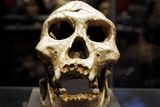Recent research has revealed that a small difference in Neanderthal DNA contributes significantly to their distinctive facial features, particularly their larger lower jaws. A study published in the journal Development has identified a specific region of the Neanderthal genome that plays a crucial role in the growth of their jaw structure, shedding light on the evolutionary divergence between Neanderthals and modern humans.
The Neanderthal genome is approximately 99.7 percent identical to that of modern humans. Yet, the physical differences, including prominent brow ridges and large noses, have puzzled scientists for years. The key to understanding these differences lies in a tiny segment of Neanderthal DNA that influences jaw development.
Unlocking the Neanderthal Genome
The groundwork for this discovery began in 2010 when researchers sequenced the first draft of the Neanderthal genome using ancient bones found in Vindija Cave in Croatia. This pioneering effort not only revealed genetic similarities but also confirmed that many modern humans carry Neanderthal ancestry due to interbreeding that occurred between 50,500 and 43,500 years ago.
Both Neanderthal and human genomes contain around 3 billion bases of DNA, which determine the formation of proteins and activate specific genes. The recent study focused on pinpointing the exact genetic variations influencing jaw size, a task described as akin to finding a needle in a haystack.
A Special Genetic Sequence
To tackle this challenge, researchers concentrated on a region associated with the Pierre Robin sequence, a rare birth defect that results in an underdeveloped lower jaw. According to Hannah Long, a geneticist at the University of Edinburgh, “Some individuals with Pierre Robin sequence have large deletions or DNA rearrangements in this part of the genome that change face development and limit jaw formation. We predicted that smaller differences in the DNA might have more subtle effects on face shape.”
The team discovered just three single-letter differences in a section of the Neanderthal genome that is approximately 3,000 letters long. While it does not contain any genes, this region regulates the activation of the SOX9 gene, which is vital for facial development.
Insights from Zebrafish Experiments
To explore the impact of these genetic differences, the researchers utilized zebrafish, known for their transparent embryos, allowing for easy observation of developmental changes. They inserted both Neanderthal and human versions of the DNA region into the zebrafish and monitored the activity of the cells responsible for jaw formation.
Excitingly, the Neanderthal version showed significantly greater activity in these cells compared to the human version. Long expressed her enthusiasm, stating, “It was very exciting when we first observed activity in the developing zebrafish face in a specific cell population close to the developing jaw, and even more so when we observed that the Neanderthal-specific differences could change its activity in development.”
The researchers further tested the effects of adding extra SOX9 genes to the embryos, which revealed that the Neanderthal DNA’s increased activity led to a larger area occupied by jaw development cells.
With this groundbreaking research, scientists now have a clearer understanding of why Neanderthals possessed larger lower jaws. Future studies may delve into how other genetic variants contribute to distinct facial features, enhancing our knowledge of human evolution.
This research highlights the intricate relationship between genetics and physical characteristics, providing invaluable insights into the evolutionary journey of our ancestors.






































































